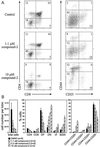Presenilin-dependent gamma-secretase activity modulates thymocyte development
- PMID: 11470902
- PMCID: PMC55417
- DOI: 10.1073/pnas.161102498
Presenilin-dependent gamma-secretase activity modulates thymocyte development
Abstract
In neuronal cells, presenilin-dependent gamma-secretase activity cleaves amyloid precursor proteins to release Abeta peptides, and also catalyzes the release of the intracellular domain of the transmembrane receptor Notch. Accumulation of aberrant Abeta peptides appears to be causally related to Alzheimer's disease. Inhibition of Abeta peptide production is therefore a potential target for therapeutic intervention. Notch proteins play an important role in cell fate determination in many different organisms and at different stages of development, for example in mammalian T cell development. We therefore addressed whether structurally diverse gamma-secretase inhibitors impair Notch function by studying thymocyte development in murine fetal thymic organ cultures. Here we show that high concentrations of the most potent inhibitors blocked thymocyte development at the most immature stage. In contrast, lower concentrations or less potent inhibitors impaired differentiation at a later stage, most notably suppressing the development of CD8 single-positive T cells. These phenotypes are consistent with an impairment of Notch signaling by gamma-secretase inhibitors and define a strict Notch dose dependence of consecutive stages during thymocyte development.
Figures






References
-
- Brown M S, Ye J, Rawson R B, Goldstein J L. Cell. 2000;100:391–398. - PubMed
-
- Haass C, De Strooper B. Science. 1999;286:916–919. - PubMed
-
- Wolfe M S, Xia W, Ostaszewski B L, Diehl T S, Kimberly W T, Selkoe D J. Nature (London) 1999;398:513–517. - PubMed
-
- Steiner H, Duff K, Capell A, Romig H, Grim M G, Lincoln S, Hardy J, Yu X, Picciano M, Fechteler K, et al. J Biol Chem. 1999;274:28669–28673. - PubMed
-
- Kimberly W T, Xia W, Rahmati T, Wolfe M S, Selkoe D J. J Biol Chem. 2000;275:3173–3178. - PubMed
MeSH terms
Substances
LinkOut - more resources
Full Text Sources
Other Literature Sources
Research Materials

